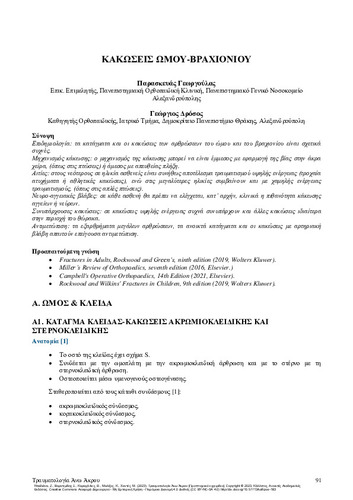| Title Details: | |
|
Shoulder and humerus trauma |
|
| Authors: |
Georgoulas, Paraskevas |
| Reviewer: |
Drosos, Georgios |
| Description: | |
| Abstract: |
Epidemiology: Fractures and injuries of the shoulder and humerus are relatively common.
Mechanism of injury: The mechanism of injury can be indirect by applying force to the extremity (such as in falls) or direct by applying direct blunt force.
Causes: In younger patients, it is usually the result of a high-energy injury (traffic accidents or sports injuries), while in older patients it also occurs with low-energy injuries, (such as simple falls).
Neurovascular damage: The possibility of damage toblood vessels or nerves should be clinically evaluated in every patient
Concomitant injuries: High-energy injuries are often accompanied by other injuries, especially in the chest.
Treatment: Dislocations of large joints, open fractures and injuries with arterial rupture require urgent treatment.
|
| Linguistic Editors: |
Pitsoli, Kalliopi |
| Graphic Editors: |
Tsakmaki, Eleni |
| Type: |
Chapter |
| Creation Date: | 18-05-2023 |
| Item Details: | |
| License: |
Attribution - NonCommercial - ShareAlike 4.0 International (CC BY-NC-SA 4.0) |
| Handle | http://hdl.handle.net/11419/9481 |
| Bibliographic Reference: | Georgoulas, P. (2023). Shoulder and humerus trauma [Chapter]. In Dailiana, Z., Varitimidis, S., Karachalios, T., Malizos, K., & Hantes, M. 2023. Traumatology of Upper Extremity [Undergraduate textbook]. Kallipos, Open Academic Editions. https://hdl.handle.net/11419/9481 |
| Language: |
Greek |
| Is Part of: |
Traumatology of Upper Extremity |
| Publication Origin: |
Kallipos, Open Academic Editions |

